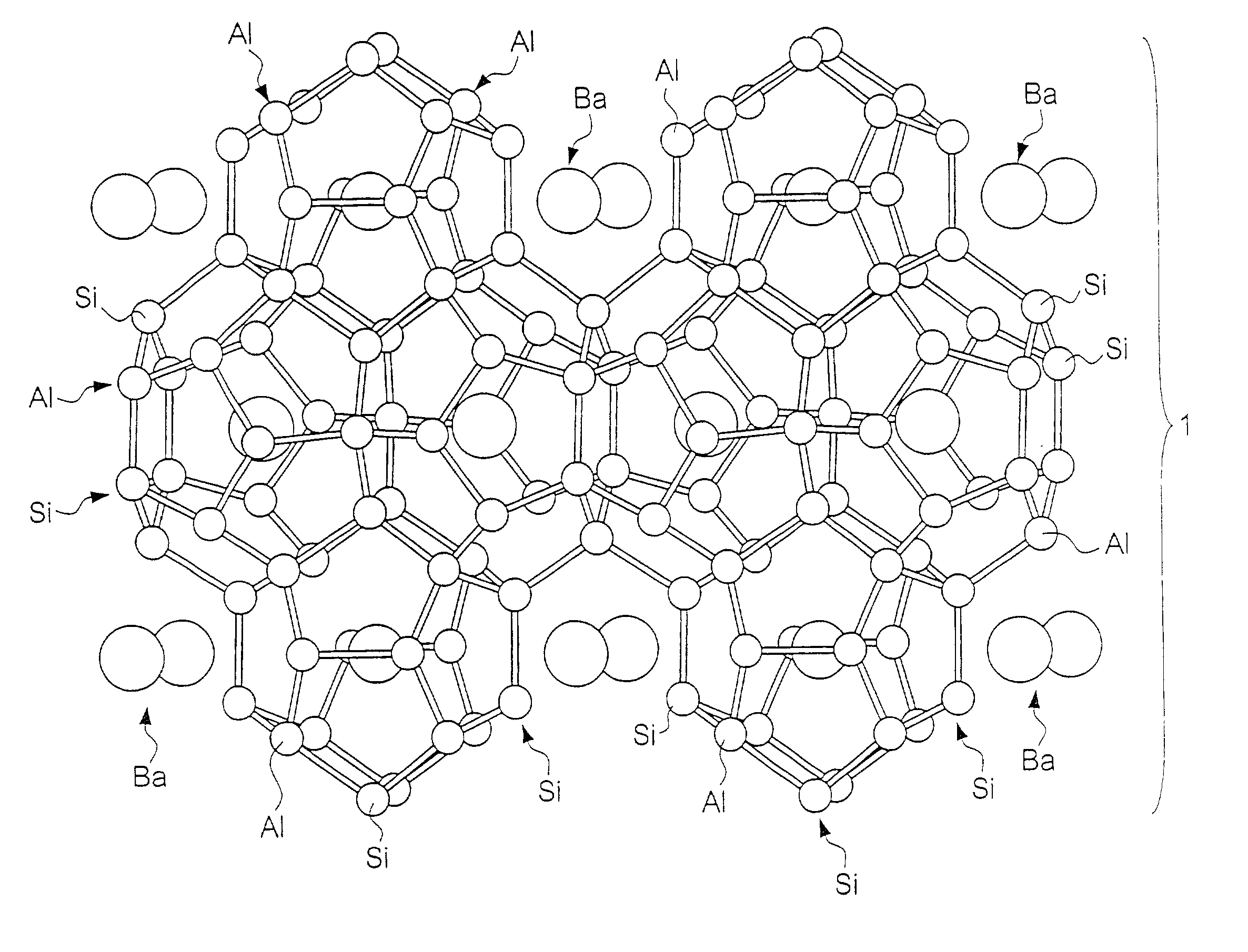Clathrate compounds, manufacture thereof, and thermoelectric materials, thermoelectric modules, semiconductor materials and hard materials based thereon
a technology of clathrate compounds and clathrate compounds, which is applied in the direction of non-metal conductors, conductors, energy input, etc., can solve the problems of limited to certain, poor thermoelectric conversion efficiency of conventional thermoelectric materials, and is problematic to propose the use of thermoelectric materials, etc., to achieve excellent applicability, favourable thermal conductivity, electrical conductivity and semiconductor like properties
- Summary
- Abstract
- Description
- Claims
- Application Information
AI Technical Summary
Benefits of technology
Problems solved by technology
Method used
Image
Examples
example 1
[0239] Powders of Ba, Si and Al were weighed and combined to produce a Ba:Si:Al constituent ratio (atom %) of 8:26:20, and a powdered mixture then prepared by mechanical alloying treatment. The powdered mixture was submitted to preliminary heating at 800.degree. C. under an atmosphere of Ar gas for a period of 24 hours, and following this preliminary heating, was then re-ground to an average granular diameter of 100 .mu.l, before undergoing plasma sintering in a plasma sintering apparatus at a temperature of 850.degree. C. and a pressure of 40 MPa for a period of 30 minutes.
[0240] X-ray analysis of the sintered product confirmed a silicon clathrate 46 Ba.sub.8@(Si.sub.26,Al.sub.20) structure in the space group Pm3m, origin at 4 3 m (note that normally in crystallographic analyses the "3" of Plm3m is displayed with an overline, but there the overline is represented by 3), and with a lattice constant of 10.3 .ANG.. Furthermore, a measurement of the figure of merit (ZT) of the sintered...
example 2
[0241] Powders of Ba, Si and P were weighed and combined to produce a Ba:Si:P constituent ratio (atom %) of 8:26:20, and a powdered mixture then prepared by mechanical alloying treatment. The powdered mixture was submitted to preliminary heating at 800.degree. C. under an atmosphere of Ar gas for a period of 24 hours, and following this preliminary heating, was then re-ground to an average granular diameter of 100 .mu.m, before undergoing plasma sintering in a plasma sintering apparatus at a temperature of 850.degree. C. and a pressure of 40 MPa for a period of 30 minutes.
[0242] X-ray analysis of the sintered product confirmed a silicon clathrate 46 Ba8@(Si.sub.26,P.sub.20) structure in the space group Pm3m, origin at 4 3 m (note that normally in crystallographic analyses the "3" of Pm3m is displayed with an overline, but here the overline is represented by 3), and with a lattice constant of 10.5 .ANG.. Furthermore, a measurement of the figure of merit (ZT) of the sintered product a...
example 3
[0244] Calcium carbide (CaC.sub.2) was melted by heating at up to 2,500.degree. C., and following solidification was insulated inside a furnace and cooled gradually to 1,000.degree. C. The furnace was then maintained at a temperature of 1,000.+-.10.degree. C. for a period of 120 hours (5 days). The resulting ingot was ground finely and washed with water. Following drying, the powder was inserted into a pressure sintering apparatus and sintered for 20 hours at 1000.degree. C. and 100 MPa. Structural analysis of the crystals obtained, by X-ray diffraction, revealed a lattice constant of 0.68 nm, and the diffraction peaks confirmed the encapsulation of Ca atoms within clusters of 20 carbon atoms and clusters of 24 carbon atoms. Composition analysis by EPMA showed a Ca:C atomic weight ratio of 7.62:45.62 as opposed to the target Ca:C ratio of 8:46. Furthermore the results of a hardness test revealed a hardness equivalent to cubic boron nitride. Moreover, confirmation or the current dire...
PUM
 Login to View More
Login to View More Abstract
Description
Claims
Application Information
 Login to View More
Login to View More - R&D
- Intellectual Property
- Life Sciences
- Materials
- Tech Scout
- Unparalleled Data Quality
- Higher Quality Content
- 60% Fewer Hallucinations
Browse by: Latest US Patents, China's latest patents, Technical Efficacy Thesaurus, Application Domain, Technology Topic, Popular Technical Reports.
© 2025 PatSnap. All rights reserved.Legal|Privacy policy|Modern Slavery Act Transparency Statement|Sitemap|About US| Contact US: help@patsnap.com



